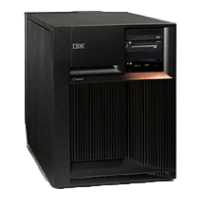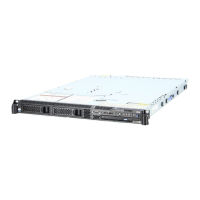v No: Go to step 15 (See page 126).
12.
Select option 5. Do the missing units have device parity protected status? (Device parity protection
status is indicated by ″DPY/″ as the first four characters of the status.)
v Yes: Continue with the next step.
v No: Go to step 14 (See page 126).
13.
Is the status DPY/Active?
v Yes: Continue with the next step.
v No: Use the Service Action Log to determine if there are any entries for the missing disk units or
the IOA/IOP controlling them. (see “Use the service action log” on page 7).
This
ends the procedure.
14.
Press F11, and press Enter to display the details.
Do all of the disk units listed on the display have a reference code of 0000?
v Yes: Do all of the IOPs or devices listed on the display have a reference code of 0000?
– No: Use the IOP reference code shown on the display and go to System Reference Codes.
Perform the action indicated for the reference code.
This
ends the procedure.
– Yes: Go to step 19 (See page 126).
v No: Use the disk unit reference code shown on the display and go to the SRC information for the
specific disk unit in System Reference Codes. Perform the action indicated for the unit reference
code.
This
ends the procedure.
15.
Does the following message appear in the list?
Unknown load-source status
v Yes: Continue with the next step.
v No: Go to step 17 (See page 126).
16. Select option 5, press F11, and then press Enter to display the details.
Does the Assign Missing Load Source Disk display appear?
v No: Continue with the next step.
v Yes: Press Enter to assign the missing load-source disk unit.
This ends the procedure.
17.
Does the following message appear in the list?
Load source failure
v Yes: Continue with the next step.
v No: The IPL completed successfully.
This
ends the procedure.
18.
Select option 5, press F11, and then press Enter to display the details.
19. The number of failing disk unit facilities (actuators) is the number of disk units displayed. A disk unit
has a Unit number greater than zero.
Find the failing disk unit by type, model, serial number, or address displayed on the console.
20. Is the failing disk unit a 9337?
v No: Continue with the next step.
v Yes: Go to step 25 (See page 127).
21.
Is there more than one failing disk device attached to the IOA or MSIOP?
v Yes: Continue with the next step.
v No: Go to step 23 (See page 127).
22. Are all the disk devices that are attached to the IOA or MSIOP failing? (If the disk units are using
mirrored protection, select Display Disk Status to find out.)
126 iSeries: iSeries Server 270, 800, 810, 820, 825, 830, 840, 870, 890, SB2, and SB3 Hardware Problem Analysis and
Isolation

